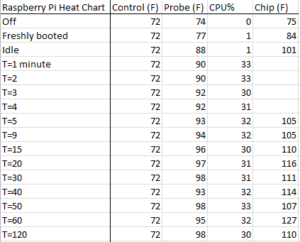Good Morning from my Robotics Lab! This is Shadow_8472, and today, I am running a looping Hello World program on my Raspberry Pi for a while to see if my work for the last few weeks needs to be redone in ABS plastic. Let’s get Started!
I’m going with the hypothesis that while the Pi may run a bit warm for PLA plastic, with the heat syncs, and ventilation, I should be okay.
My procedure will involve using an infrared temperature sensor I borrowed from the workshop I joined a couple months ago. After messing with it for a while, I figured out how to use the temperature probe that came with it. I’ve taped the probe in the space I’m most concerned about overheating as I don’t have a line of sight view of the place.
Each data point I take will track the ambient temperature of a consistent point nearby, the temperature of the probe, the CPU speed, and some points will take the temperature of a chip on the inverted Pi’s exposed underside, but only when data points are coming in after 5 minutes or more.
***
I’ve started collecting data. The probe wire is notoriously difficult to keep in place. I took data points while it was off and freshly booted. Nothing much changed temperature wise except the chip getting a little warmer. I’ll include a screenshot of my results later.
***
It’s part way through data collection. I may have skewed the results of collecting the data on the chip on the top side by measuring at a different angle. Ambient temperatures are fairly steady but the probe location below the heat syncs is slowly climbing. I just took another measurement, and the possibly skewed one doesn’t seem like I’ll need to throw it out after all. I was hoping it was my readings and not a temperature spike. I’m also concerned that the probe may be slipping, especially if it’s getting closer to the heatsink.
***
The probe was slipping! Its readout was growing steadily as the tape holding it in place gave way. My data at T=40 minutes and on will have it correctly positioned.
***

***
Estimates of the low end for PLA softening are around 60 degrees C or 140 F. In conclusion: While I believe my data has a large margin of error, I do not believe it is so great as to void my conclusion that it is safe for my case to operate my Pi under these conditions.
The Pi only ever reached 33% CPU usage, I believe it was throttled by the task of writing to a command line. If it were to run hotter, the plastic might still be in danger. I will need to redo this test when I’m running image analysis on it.
Final Question: How else can I improve my tests?

